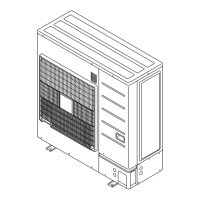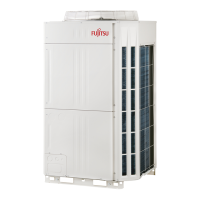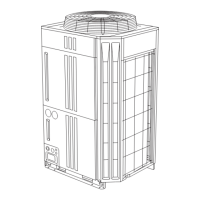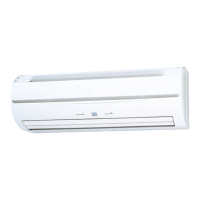En-14
7. 2. 2. Terminating resistor setting
CAUTION
Be sure to set the terminal resistor according to specifi cations.
Set the terminal resistor for every network segment (NS).
If terminal resistor is set in multiple devices, the overall communication system may
be damaged.
If terminal resistor is not set in a device, abnormal communication may occur.
• Be sure to set 1 terminal resistor in a network segment. You can set the terminal
resistor at the outdoor unit or signal amplifi er.
• When setting the terminal resistor of a signal amplifi er, refer to the installation manual
of the signal amplifi er.
• When setting multiple terminal resistors, take note of the following items.
1
How many network segments are there in a VRF system?
2
Where will you set the terminal resistors in a network segment? (Condition for 1
segment: Total number of outdoor and indoor units and signal amplifi ers is less than
64, or the total length of the transmission cable is less than 500m)
3
How many outdoor units are connected to 1 refrigerant system?
Confi gure the setting (DIP switch SET5) of the terminal resistor of the outdoor units as
shown below from conditions
1
to
3
.
SET5
Terminal resistor Remarks
4
OFF Disable -
ON Enable (Factory setting)
Figure: Terminal resistor setting
NS2 (Network segment 2) NS3 (Network segment 3)
NS4 (Network segment 4)
NS1 (Network segment 1)
(Set terminal resistor at outdoor units)
Master unit
Master unit
Master unit
Refrigerant system1
Refrigerant system2
Refrigerant system3
Terminal resistor: off
Terminal resistor: on
Terminal resistor: on
About the setting of terminal resistor
Outdoor unit
Install
Do not install
:on
:off
Signal amplifi er
7. 3. Rotary switch setting
The rotary switch (REF AD) sets the refrigerant circuit address of the outdoor unit. Con-
fi gure the settings only on the master unit of a refrigerant system.
If multiple refrigerant systems are connected, set the rotary switch (REF AD) as shown
in the table below.
Refrigerant
circuit
address
Rotary
Switch
Setting
Setting
Setting
range
Type of switch
REF AD
×10 ×1
Refrigerant
circuit
address
0–99
Setting
example
63
000
101
202
··· ··· ···
REF AD × 10
REF AD × 1
··· ··· ···
Rotary Switch (REF AD × 1): Factory setting “0”
Rotary Switch (REF AD × 10): Factory setting “0”
98 9 8
99 9 9
7. 4. Push button setting
Various functions can be set when necessary.
Perform settings after all indoor units have stopped operation.
Table. A: List of Settings
No Setting Item
7 segment LED indicator
Factory
setting
First 2
digits
Last 2 digits
00
(Forbidden) 0 0 0 0
○
(Factory setting)
10
(Forbidden) 1 0 0 0
○
(Factory setting)
11
Cooling capacity
shift
Normal mode
11
00
○
Save energy mode 0 1
High power mode 1 0 2
High power mode 2 0 3
(Forbidden) 0 4
Set this item when necessary.
12
Heating capacity
shift
Normal mode
12
00
○
Save energy mode 0 1
High power mode 1 0 2
High power mode 2 0 3
Set this item when necessary.
13
(Forbidden) 1 3 0 0
○
(Factory setting)
14
(Forbidden) 1 4 0 0
○
(Factory setting)
16
(Forbidden) 1 6 0 0
○
(Factory setting)
17
Height diff erence
between indoor
units
Standard
17
00
○
Forbidden 0 1
Height diff erence 0 2
Forbidden 0 3
Forbidden 0 4
If installing the indoor units (even only one set) to a lower fl oor than the outdoor
unit, and the height diff erence between the indoor units is 3m or greater (i.e., if
installing the indoor units on separate fl oors), set “02 (height diff erence)”.
20
Switching between
batch stop or
emergency stop
Batch stop
20
00
○
Emergency stop 0 1
This mode selects the pattern of the stop function to be operated by the external
input terminal (CN134).
• Batch stop: The stop of all indoor units connected to same refrigerant system
due to input signal coming from CN134.
• Emergency stop: When emergency stop is actuated, the indoor unit does not
accept the operation command from the remote controller. On the other hand,
when the emergency stop is released (no input from CN134), the air condi-
tioner does not return to the original operation until the indoor unit is turned on
by the remote controller.
21
Operation mode
selecting method
Priority given to the fi rst com-
mand
21
00
○
Priority given to external input
of outdoor unit
01
Priority given to administra-
tive indoor unit
02
Select the priority setting of the operation mode.
• Priority given to the fi rst command: Priority is given to the operation mode which is
set fi rst.
• Priority given to external input of outdoor unit: Priority is given to the operation
mode which is set by the external input terminal (CN132).
• Priority given to administrative indoor unit: Priority is given to the operation mode
of the administrative indoor unit which is set by the wired remote controller.
22
(Forbidden) 2 2 0 0
○
(Factory setting)
23
(Forbidden) 2 3 0 0
○
(Factory setting)
24
(Forbidden) 2 4 0 0
○
(Factory setting)
25
(Forbidden) 2 5 0 0
○
(Factory setting)
26
(Forbidden) 2 6 0 0
○
(Factory setting)
27
(Forbidden) 2 7 0 0
○
(Factory setting)
28
(Forbidden) 2 8 0 0
○
(Factory setting)
29
(Forbidden) 2 9 0 0
○
(Factory setting)
30
Outdoor unit
capacity save
setting
Level 1 (stop)
30
00
○
Level 2 0 1
Level 3 0 2
Level 4 0 3
Level 5 0 4
The capacity limit can be selected by the external input terminal (CN133) when
operating with the “Energy Saving Peak Cut function”.
The lower the level, the more the eff ect of energy saving, but the cooling/heating
performance will also drop.
9380545149-02_IM_EN.indd 149380545149-02_IM_EN.indd 14 9/7/2021 1:38:54 PM9/7/2021 1:38:54 PM

